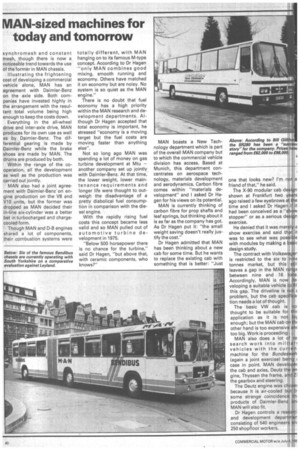MAN-sized machines for today and tomorrow
Page 28

If you've noticed an error in this article please click here to report it so we can fix it.
synchromesh and constant mesh, though there is now a noticeable trend towards the use of the former in MAN chassis.
Illustrating the frightening cost of developing a commercial vehicle alone, MAN has an agreement with Daimler-Benz on the axle side. Both companies have invested highly in the arrangement with the resultant total volume being high enough to keep the costs down.
Everything in the all-wheel drive and inter-axle drive, MAN produces for its own use as well as by Daimler-Benz. The differential gearing is made by Daimler-Benz while the brake shoes are made by MAN. The drums are produced by both.
Within the range of the cooperation, all the development as well as the production was carried out jointly.
MAN also had a joint agreement with Daimler-Benz on engine production on the V8 and V10 units, but the former was dropped as MAN decided their in-line six-cylinder was a better bet in turbocharged and chargecooled form.
Though MAN and D-B engines shared a lot of components, their combustion systems were totally different, with MAN hanging on to its famous M-type concept. According to Dr Hagen "only MAN combines good mixing, smooth running and economy. Others have matched it on economy but are noisy. No system is so quiet as the MAN engine."
There is no doubt that fuel economy has a high priority within the MAN research and development departments. Although Dr Hagen accepted that total economy is important, he stressed "economy is a moving target but the fuel costs are moving faster than anything else".
Not so long ago MAN was spending a lot of money on gas turbine development at Mtu — another company set up jointly, with Daimler-Benz. At that time, the lower weight, lower maintenance requirements and longer life were thought to outweigh the disadvantage of a pretty diabolical fuel consumption in comparison with the diesel engine.
With the rapidly rising fuel costs this concept became less valid and so MAN pulled out of automotive turbine development in 1975.
"Below 500 horsepower there is no chance for the turbine," said Dr Hagen, "but above that, with ceramic components, who knows?" MAN boasts a New Technology department which is part of the overall MAN company but to which the commercial vehicle division has access. Based at Munich, this department concentrates on aerospace technology, materials development and aerodynamics. Carbon fibre comes within "materials development" and I asked Dr Hagen for his views on its potential.
MAN is currently thinking of carbon fibre for prop shafts and leaf springs, but thinking about it is as far as the company has got. As Dr Hagen put it: "the small weight saving doesn't really justify the cost."
Dr Hagen admitted that MAN has been thinking about a new cab for some time. But he wants to replace the existing cab with something that is better: "Just one that looks new? I'm not a friend of that," he said.
The X-90 modular cab design shown at Frankfurt two years ago raised a few eyebrows at the time and I asked Dr Hagen if it had been conceived as a "show stopper" or as a serious design exercise. .
He denied that it was merely a show exercise and said that il was to see what was possible with modules by making a bask design study.
The contract with Volkswager is restricted to the six to nin€ tonnes market, but this itil leaves a gap in the MAN rang€ between nine and 16 tops Accordingly, MAN is now de veloping a suitable vehicle to fil this gap. The driveline is not problem, but the cab specifi a tion needs a lot of thought.
The basic VW cab is thought to be suitable for application as it is not lc enough; but the MAN cab on h■ other hand is too expensive i c too big. Work is proceeding, !
MAN also does a lot of -IJe search work into militar) vehicles with the curren machine for the Bundesweh (again a joint exercise) being case in point. MAN developec the cab and axles, Deutz the on gine, Thyssen the frame, and Z' the gearbox and steering.
The Deutz engine was chosel because it is air-cooled but b some strange coincidence th products of Daimler-Benz ani MAN will also fit.
Dr Hagen controls a researc and development departmer consisting of 540 engineers an 250 shopfloor workers.












































